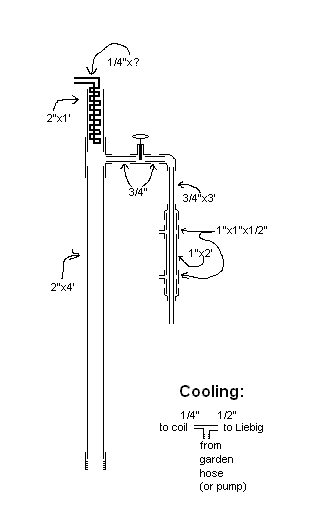Hi mrdrbubba
I found this on a distilling forum about a year ago and I can’t remember who posted it so if Mike N recognises this thank you. The question asked was:-
Can anyone please explain the working principle of a vapour management still head. What are its advantages/disadvantages over
the nixon-stone type?
I've seen pictures of this type of head on
http://homedistiller.org onclick="window.open(this.href);return false;" rel="nofollow but have yet to find a description of how they work.
=====================
Here we go. I'll try and make it as short as possible.
If you feed vapour to the middle point of a horizontal tube, then it will split into two streams.
If the cross-sectional area of one arm of the tube is A and the other is B, then the vapour will divide in that ratio, A/B.
You can control that cross-sectional area by means of gate valves, and this is useful for some applications.
If you feed vapour into the middle point of a vertical tube, density now becomes a factor and this can be used to control the behaviour of a distilling column depending on the composition of the vapour inside.
First thing to note is that vapour rises in a distillation column not because if convection, as some think, but because it is pushed by vapour generated in the boiler. All vapour in a distillation column therefore rises at the same rate no matter what its density, and at a rate determined by the power pumped into the boiler.
When vapour meets the middle point of the vertical tube, some will be driven further up the column and some will enter the tube. In practise, this middle feed point is sealed off by a gate valve in a side arm during stabilisation of the column, and the vertical tube comprises the path up to the top condenser and the path down to the product condenser. It is a 'kinked' vertical tube fed with vapor at its middle point. When the gate valve is opened, vapour enters the side arm and, if it is less dense than air, will try to rise. If it is denser than air then it falls. It cannot rise in the side arm as that arm only goes down, but can fall as it points down to the product condenser and collecting vessel. The gate valve controls amount that can enter the side arm.
The relative densities of steam at 100C, air at room temperature, and ethanol vapor at 78C are 0.6/1.0/1.6
If the vapour in the column is ethanol, then it will fall down through the product arm, and if it is steam then it will continue up to the top condenser. The changeover point, when the vapor in the column is the same density as air, if when the vapour comprises 45.5% ethanol and 54.5% steam. The volume of vapour falling down through the side arm therefore tails off and finally stops as the vapour mix in the column approaches and then reaches this point. As this represents the onset of tails, the side arm being at the top of the column, a vapour management still automatically stops delivering product before it is contaminated with a significant amount of tails. It is also the reason why you cannot test the operation of such a still using steam alone. Subsequent collection of tails can be done by turning off the top condenser, blocking that path with a rag in the top vent, and fully opening the gate valve. A rag is recommended for blocking the top vent as a gate valve would present the possibility that both gate valves could be closed together, sealing the whole still.
Sorry if that still seems long winded. I would seriously welcome any summary that manages to cover everything more concisely.
Mike N
That about sums it all up
Cheers Geoff
